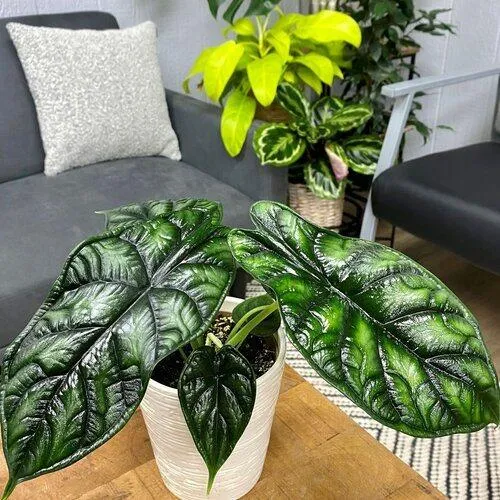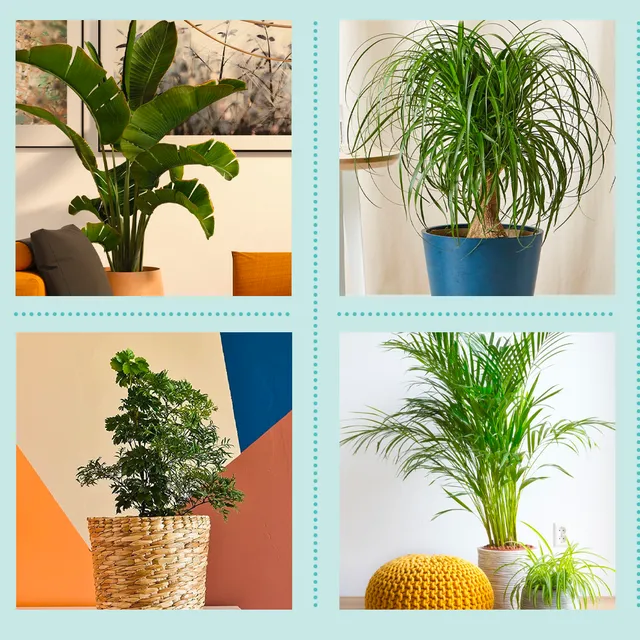Your Guide to Choosing the Best Tall Variegated House Plants
If you’re looking to add some height and visual interest to your home with beautiful variations in leaf color, tall variegated house plants are excellent options to consider. In this article, I will discuss the top variegated plants that grow well indoors and reach 3 feet or taller, as well as tips for caring for them so they thrive. By the end, you’ll have all the information you need to select plants perfectly suited to your space and maintenance level.
Top Tall Variegated House Plant Picks
- Dracaena marginata: Also called dragon tree, this is one of the most popular variegated indoor plants. It has long, strap-like leaves that are often mostly green with white margins. Dragon trees can grow 6 feet tall over many years. They tolerate low light.
- Philodendron selloum: With its heart-shaped leaves streaked with silvery veins, Philodendron selloum is a showstopper. It loves climbing poles or moss poles to reach heights over 6 feet. Offering moisture but allowing the soil to dry slightly between waterings suits it best.
- Ficus benjamina: Commonly called weeping fig, this tree-like plant features elongated green leaves edged in cream or white. It thrives in medium to low light. Prune it regularly to maintain a full, bushy shape up to 6 feet tall. Provide consistent moisture.
Caring for Tall Variegated Plants
Proper care is key to helping your tall variegated plants thrive indoors for many years. Here are some tips:
- Watering: Allow the top inch of soil to dry out between waterings. Overwatering is a common cause of yellowing leaves. Group plants with similar water needs.
- Fertilizing: Use a diluted liquid houseplant food every two weeks in the spring and summer when plants are actively growing. Cut back to monthly in fall and winter when growth slows.
- Light: Most tall variegated plants grow best in medium to low light, such as an east or north-facing window. Rotate plants weekly for even growth. Use grow lights if natural light is insufficient.
- Pruning: Trim off any damaged, diseased or drying branches or leaves to maintain a full shape. This encourages new growth.
- Repotting: Transfer to a fresh pot with new soil only when roots fill the container. Do so in spring, using a pot just 1-2 inches larger.
Dealing with Potential Pests and Problems
While generally low-maintenance, tall variegated plants can face occasional issues. Here are the most common and how to treat them:

- Mealybugs: Fluffy white insects that suck plant sap. Wipe leaves with cotton balls dipped in rubbing alcohol. Spray neem oil as a preventative.
- Scale: Hard, crusty bumps that cling to leaves and stems. Scrape off with your fingernail or a cotton ball with rubbing alcohol.
- Spider mites: Tiny red or green specks on undersides of leaves with webbing. Isolate plant and spray thoroughly with water to dislodge mites. Apply neem oil.
- Yellow leaves: Too much or too little water, low humidity or fertilizer imbalance likely cause. Adjust care and remove affected foliage.
Creating an Ideal Home Environment
To really maximize the growth and beauty of your tall variegated plants, mimic their native tropic or sub-tropic conditions indoors. Here are some tips:
- Provide medium to high humidity levels around 50-60% with a humidifier or pebble tray filled with water beneath pots.
- Use a soil mixture suited for houseplants that drains well while retaining moisture. A cactus/succulent or orchid mix works great.
- Group plants together for support and to raise the ambient humidity around them. Place your tallest varieties in the back.
- Supplement daylight entering windows with artificial grow lights if necessary to adequately light your whole plant collection.
Personalizing Your Plant Display
Once you’ve selected your tall variegated beauties and learned how to care for them, have fun customizing their display! Consider using plant stands, shelving, hanging baskets or moss poles for support and visual appeal.
From my experience, dressing up plain nursery pots with decorative saucers, ribbons or pebbles adds personality. I’ve also witnessed how strategic placement of plants in the home, like flanking windows or beside an easy chair for a reading nook, makes living spaces feel greener and more inviting. Have fun expressing your own style!

With some TLC, your variegated plants can thrive for years to come, imparting natural beauty and interest to any room. I hope this guide has covered all the essential information to choose great specimens and ensure their success indoors. Let me know if you have any other questions down the road!
Tall Variegated House Plants Comparison
| Plant | Average Height | Light Needs | Care Level | Variegation Pattern |
|---|---|---|---|---|
| Dracaena Fragrans Massangeana | 6-10 feet | Low to medium | Easy | Cream stripes |
| Dieffenbachia | 3-6 feet | Medium to bright indirect | Easy | White splashes |
| Philodendron Selloum | 6-10 feet | Low to medium | Easy | Cream edges |
| Chinese Evergreens | 2-6 feet | Low to bright indirect | Easy | White edges |
| Ficus Elastica | 6-10 feet | Medium to bright | Easy | Yellow stripes |
| Monstera Deliciosa | 6-10 feet | Medium to bright indirect | Easy | Variable holes |
FAQ
-
What kinds of tall variegated house plants can I grow indoors?
There are quite a few options for tall variegated plants that do well inside. Some popular choices are rubber trees, dracaena, spider plants, and peace lilies. Raphs usually reach 6 feet tall over time and have interesting patterns on their leaves. Dracaenas come in all sorts of flashy color combos and can get pretty big too. Spider plants have long variegated leaves and spread nicely in hanging pots. Peace lilies clean the air pretty good and their white flowers look sorta like lilies – nice addition if you ask me!

-
How much sunlight do tall variegated house plants need?
Most variegated indoor plants do best with partial to bright sunlight. Direct sunlight all day may burn their leaves. At the same time, too little light means they won’t grow well. Aim to put them in spots getting morning sun or protected afternoon sun. A south or west-facing window is ideal for most types. If light is dimmer, rotate them weekly so all sides get some rays. Basically, variegated plants want as much indirect light as you can give them without scorching their foliage.
-
How often should I water tall variegated house plants?
The frequency of watering depends on the type of plant and potting soil mix. As a general rule, check the soil regularly and water when the top inch becomes dry. Let the excess liquid drain out the drainage holes. During the growing season when they’re actively putting on new growth, most varieties need water about once every 7-10 days. In the winter when light and temps are lower, cut back to every 2-3 weeks. Overwatering is basically the main issue to avoid as their roots prefer to dry out between waterings.
-
What kind of fertilizer is suitable for tall variegated house plants?
All variegated plants appreciate a balanced liquid fertilizer to keep them looking their best. Dilute water-soluble formulas according to package instructions and feed monthly during the spring and summer. Slow release granular varieties work well too when repotted into fresh soil. Be careful not to over-fertilize, which can burn their roots. Peace lilies, however, don’t need as much fertilizer as some others. Fish emulsion is a good organic choice that most unusual plants seem to like. Whatever you use, less is more when it comes to fertilizing variegated beauties in the home.

-
Do tall variegated house plants require pruning or shaping?
Some trimming or grooming may help tall indoor variegated plants stay bushy and full. Rubber tree branches tend to get long and lanky over time. It’s fine to snip them back by a third or more to promote more compact growth. Spider plants and dracaena can get leggy too if not pruned occasionally. Some people like to pinch off rubbers tree flowers, while others let them bloom for fun. Either way works well for these showy plants. Drastic pruning in winter when they’re dormant is usually not needed unless you want to really train or shape them.
-
How do I prevent pests on my tall variegated house plants?
Good hygiene is the best prevention against common plant pests like spider mites, scale, and mealybugs. These soft-bodied insects can invade plants that are stressed by overwatering, drafts, or underwatering. Check leaves and stems regularly for signs of infestation. Routine inspections let you catch small problems before they spread. Isolate and thoroughly shower new plants you bring home before adding them to your collection to stop pests hitching a ride. Sure, pests may occur despite your best efforts. Nevertheless, regular care and tidy growing conditions are usually enough to keep unusual indoor plants healthy and hassle-free overall.
-
What are some tips for displaying tall variegated house plants decoratively?
Get creative when styling variegated plants around your home! Mix dramatic foliage with materials like rattan or natural fibers for visual interest. Taller kinds make cool living room accents when grouped together against a wall. Spider plants add verdant charm when draped along mantlepieces or hanging baskets. Bold leaf patterns pop when backlit by a window. Try combining different heights and textures for an artful jungle vibe. Questions to ask your design pals for advice too. On the other hand don’t be afraid to experiment on your own either until you find an arrangement you think looks nice.
